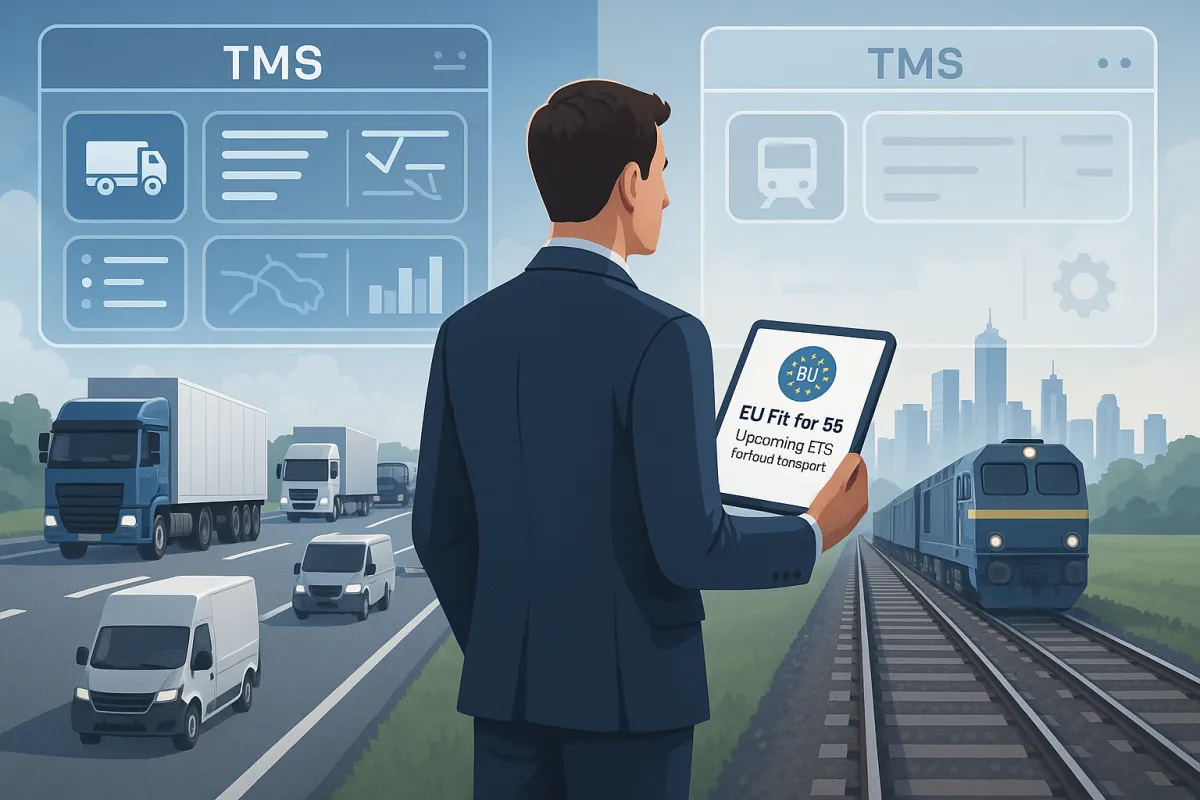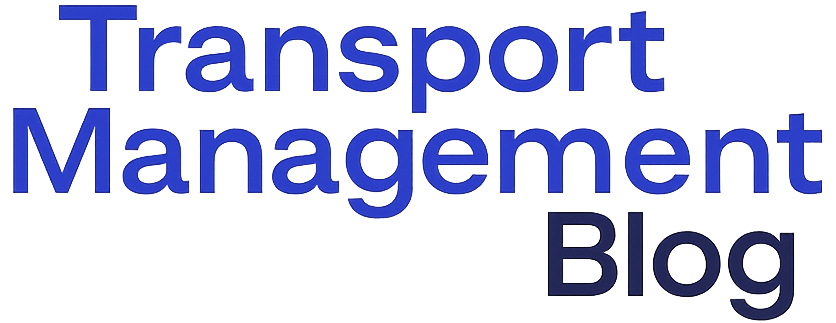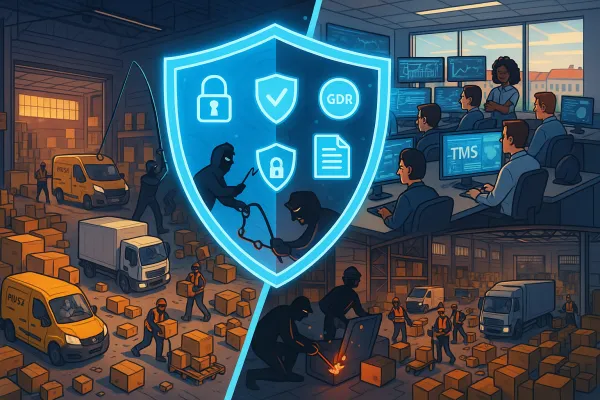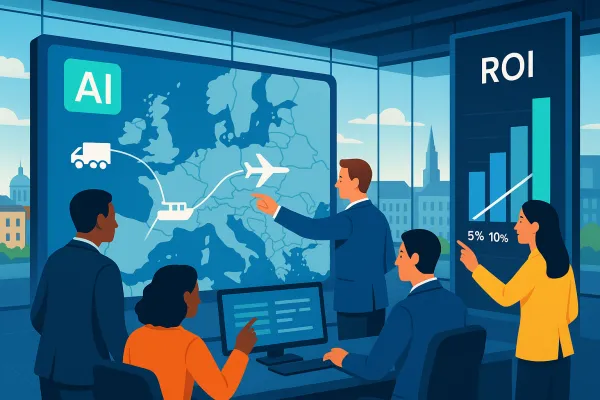The Modal Shift Readiness Gap: How European Shippers Can Future-Proof Their TMS Before Regulatory Pressure Forces Expensive Last-Minute Changes

The 92.7% modal share held by road and maritime transport in 2023, with rail at just 5.5%, reveals the scale of challenge European shippers face. Your TMS wasn't built for this shift.
EU's Fit for 55 targets and the expanding ETS to road transport from 2025 aren't waiting for your systems to catch up. Yet most TMSs require expensive integration and customization processes that make them unaffordable for many companies, while the few that handle rail treat it as an afterthought, not a core transport mode requiring sophisticated management.
The €2 million question facing European transport managers: prepare your multimodal TMS infrastructure now, or scramble to adapt when regulatory pressure forces expensive last-minute changes?
The €50 Billion Modal Shift Reality: Why European Shippers Can't Wait
On the Brenner corridor alone, returning to 2021 rail levels could save roughly 70,000-75,000 tonnes of CO₂ annually. Scale that across Europe, and rail freight volumes need to increase by 50% within nine years, then double by 2050.
The math doesn't lie. Rail generates around 17g CO₂/tkm versus 47g CO₂/tkm by road in Europe, dropping to just 2g vs. 47g in France's rail network. A separate ETS for commercial road transport launches January 2025, creating a level playing field where rail companies already pay for most external costs.
But here's the reality check: flat-to-low-growth economic climate in Europe has led to weakening freight demand and declining road haulage rates, impacting the viability of existing rail freight/intermodal services. The modal shift isn't happening organically.
Your competitors using SAP TM, Oracle TMS, or legacy systems face the same challenge. Most transport management platforms excel at road optimization but struggle with rail's unique requirements: longer lead times, capacity constraints, cross-border complexity, and intermodal handoffs that can't be managed like truck scheduling.
The TMS Integration Minefield: Why Current Systems Aren't Rail-Ready
Rail operates differently. While your TMS optimizes delivery windows for next-day road freight, rail requires planning 7-14 days ahead for capacity allocation. Rail networks are often fragmented across multiple operators and infrastructure managers, each with their own systems, data formats, and operational practices.
The integration challenges compound quickly. A German automotive parts manufacturer discovered their €800,000 TMS implementation mistake when their primary carriers couldn't integrate without costly custom development, forcing a complete re-implementation.
Most TMSs handle rail as a basic carrier option, not recognizing the fundamental differences in operations management. You can't track a rail wagon like a truck. Cross-border movements involve multiple railway undertakings, gauge changes, and customs procedures that road-focused systems weren't designed to manage.
Robust Rail TMS solutions eliminate manual inefficiencies by automating repetitive tasks like scheduling, tendering, and billing, with features such as automated Bill of Lading generation and contract enforcement. But most general-purpose platforms lack these rail-specific capabilities.
The Digital Rail Infrastructure Revolution: What's Actually Happening in 2025
Europe's Rail FP1-MOTIONAL project explores solutions for the European Traffic Management System (TMS) and Capacity Management System (CMS), for multimodal rail integration paving the way towards the Single European Railway Area.
Europe's Rail Joint Undertaking proposes an €18 billion investment from 2028 to 2034 to strengthen European competitiveness, deliver greener transport, and drive technological sovereignty. This isn't theoretical planning - demonstration activities are structured in 76 demonstrations and 163 Use Cases.
The technical infrastructure is advancing rapidly. Use cases cover cross-border scheduling, collaborative yard capacity planning, integration of traffic management systems with network capacity planning, timetable optimization algorithms, and impact of ETCS and Connected Driver Advisory System on Capacity Management System and TMS.
Integration layers now translate and harmonise data exchanged between TMS and C-DAS systems, ensuring train schedules, paths, and operational updates can be delivered consistently while managing data formats, communication protocols, and synchronisation requirements.
This affects TMS vendors like Transporeon, nShift, and emerging platforms. The question isn't whether rail digitalization will happen, but whether your TMS will integrate seamlessly when it does.
The Five-Step TMS Modal Shift Preparation Framework
Start with an honest audit of your current rail connectivity. Can your TMS handle multiple railway undertakings per shipment? Does it manage gauge changes, cross-border documentation, and capacity reservations specific to rail corridors?
Step 1: Evaluate Rail Network Integration Capabilities
Test your TMS against real multimodal scenarios. Rail freight offers 12-18 day transit times compared to 30-40 days by sea, but only if your system can coordinate intermodal transfers efficiently. Document where manual interventions are required.
Step 2: Assess Intermodal Booking and Tracking Features
Rail requires different tracking methodologies than road transport. Centralized platform systems with advanced analytics tools turn raw data into actionable insights, while scorecards offer carrier performance views and detailed reports highlight supply chain bottlenecks.
Step 3: Test API Integrations with Rail Infrastructure Managers
European rail infrastructure managers are implementing digital standards, but compatibility varies. Solutions addressing transport disruptions require defining interfaces and information exchange between Air Transport Management Systems and rail Traffic Management Systems. Your TMS needs similar rail-specific integrations.
Step 4: Pilot Multimodal Route Optimization
Run parallel tests comparing your current road-only optimization against multimodal alternatives. Modern TMS systems enable effective transport management by developing accurate vehicle schedules and better order matching, while helping plan optimal routes to reduce transport costs.
Step 5: Plan Enhanced Analytics and Carbon Reporting
ETS compliance requires accurate emissions tracking across transport modes. The Eurasian railway route generated 36.5 thousand tonnes CO2 in 2020, compared to 19,273 thousand tonnes if transported by air. Your TMS must calculate and report these differences accurately.
The Rail Connectivity Matrix: Evaluating Your TMS Options
Compare platforms on rail-specific criteria, not general transport management features. Can the system handle Rolling Road (RoLa) operations? ÖBB Rail Cargo Group reported carrying over 160,000 trucks via RoLa across the Brenner in 2021.
Modern platforms like Cargoson, alongside MercuryGate and Descartes, are building rail-first capabilities rather than treating rail as an add-on. Leading TMS providers like MercuryGate, Descartes, and Cargoson are preparing eFTI-compatible solutions that combine regulatory compliance with transport optimization capabilities.
Evaluate how each platform handles capacity management, since railcars that sit idle due to poor scheduling or overlooked maintenance directly hurt operational efficiency and bottom line.
Cost-Benefit Analysis: The €2M Question of Early vs. Late Adoption
Calculate the true cost of waiting. Early adopters like Modern Transportation realized $5 million annual savings after adopting multimodal TMS, from reduced document handling, faster customs clearance, and improved carrier performance management.
Compare this against late adoption costs. Revenues from carbon pricing will be higher, meaning more funds to support environmentally friendly transport modes. Companies that prepare now capture these incentives; those who wait face penalty costs.
Solutions like Cargoson, nShift, and Alpega position themselves to capture efficiency gains while ensuring compliance, with companies preparing for eFTI early benefiting from significant competitive advantages.
Implementation costs vary significantly. Budget €500,000-€2 million for comprehensive multimodal TMS upgrades, depending on current system complexity and required integrations. Factor in 6-18 months for implementation, plus ongoing API maintenance costs as rail infrastructure evolves.
The 2026-2030 Roadmap: Timing Your TMS Modal Shift Strategy
The eFTI implementation follows a phased approach, with the Commission adopting remaining specifications by September 2025, platforms preparing for operations from January 2026, and Member States potentially accepting data from certified platforms.
Map your TMS preparation to regulatory timelines. The new ETS system becomes operational in 2025, with a cap on emissions from 2026. EU investments in Trans-European Transport Network corridors include projects like the Brenner Base Tunnel set for completion after 2030.
Your implementation window: Start TMS evaluation now, pilot multimodal capabilities by Q2 2026, and complete full deployment by 2027. Travel Wise solution demos run from mid-2025 to mid-2027, with detailed results including roadmaps and recommendations for exploitation and scalability.
The companies preparing their transport management system modal shift capabilities now will capture the benefits of EU's Sustainable and Smart Mobility Strategy, which aims to increase rail freight's modal share through policy measures, financial incentives, and funding under the Connecting Europe Facility for upgrading rail infrastructure.
Those who wait will face the costly scramble to adapt systems under regulatory pressure, paying premium prices for rushed implementations while competitors leverage optimized multimodal networks.
The modal shift readiness gap is real. Close it before it closes your competitive position.





